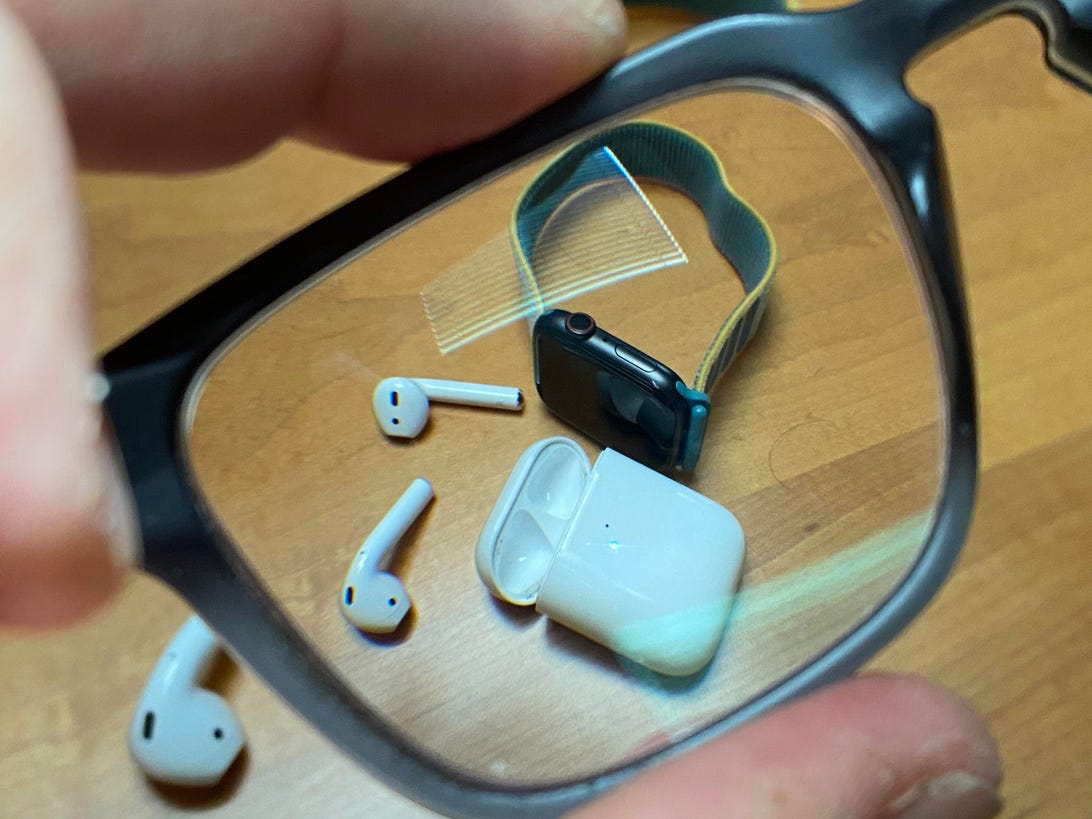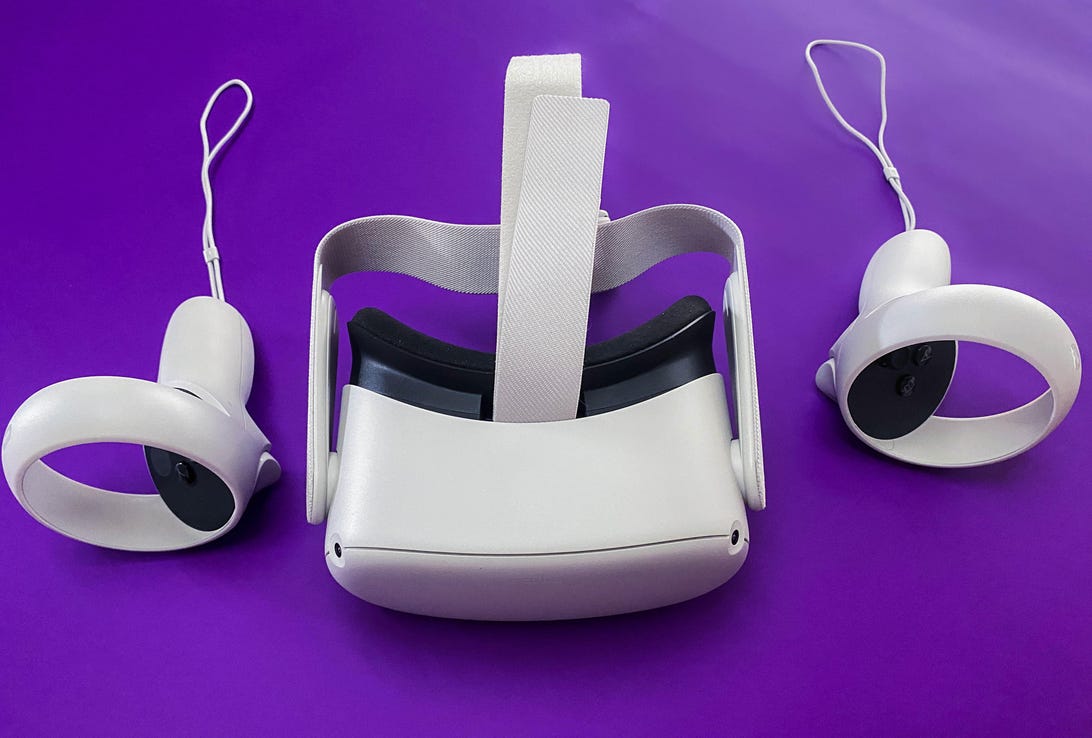
Taking a look at Apple’s other wearable devices could point to where Apple Glasses are heading.
Scott Stein/CNETMany products shown off at CES 2022 were about future tech, like cars that change color, robot butlers or invisible headphones. But with rumors that Apple may announce its own take on an augmented reality or virtual reality device sometime this year, companies already making such products are getting dragged into the present.
Chinese TV maker TCL, for example, announced at CES its RayBan-style NXTWear Air glasses that overlay computer-generated images on the real world. Sony used CES to make a surprise announcement about its hotly anticipated PlayStation VR 2 headset, which promises to trick your brain into thinking you’re inside a computer-generated world. Qualcomm and Microsoft, meanwhile, announced a new partnership for head-mounted technology chips.
Indeed, technology built around the digital worlds of the “metaverse” was a central theme of 2022’s Consumer Electronics Show, which took place both online and in-person in Las Vegas last week. The roughly 2,300 companies that participated showed off all sorts of products, like backpacks and wallets with beacon locators and shockingly close-to-human robots. But a good deal of the buzz at the show focused on head-mounted technology, particularly the headsets from TCL and Sony.
That buzz was there for good reason. The tech world has repeatedly been surprised by competitors that sweep in and take the industry by storm. Amazon did that with its Kindle reading device, which sold out within hours of its initial launch in November 2007. Smartwatch startup Pebble pulled off a similar surprise with its 2012 Kickstarter campaign that topped $7 million in a matter of weeks.
And then there’s Apple, which regularly influences and upends the industry. That very specifically happened 15 years ago in January 2007 when Apple co-founder Steve Jobs announced his company’s first iPhone during the Macworld Expo in San Francisco. That happened the same week as CES, pulling attention away from the show and the new phones, which the iPhone ultimately killed off in the marketplace.
“The industry doesn’t want to be burned like they were with the iPhone,” Moor Insights and Strategies analyst Patrick Moorhead said.
Apple co-founder Steve Jobs lounges onstage with the newly announced iPad in 2010.
James Martin/CNETBut they were burned again pretty quickly. In 2010, a rush of tech companies including Motorola, Hewlett-Packard and Dell announced competing tablets ahead of Apple’s expected introduction of the iPad. More than a decade later, Apple leads the industry with more than 31% market share, according to IDC. Motorola, meanwhile, no longer makes its once-hyped Xoom tablet. HP and Dell, whose devices were stars of CES 2010, sit far below other industry leaders like Samsung, Lenovo and Amazon.
“The industry’s a lot more ready for this one, and it’s been investing in years,” Moorhead said. “You have all these people who are like, ‘never again.'”
Apple, which didn’t respond to a request for comment, typically doesn’t discuss rumors of upcoming products.
Still, Apple CEO Tim Cook has teased his company’s interest in AR and VR, either through its software tools offered to developers or statements that the technology is a “critically important part of Apple’s future” that will “pervade our entire lives.”
“I think AR is one of these very few profound technologies that we will look back on one day and went, ‘How did we live our lives without it?'” he told tech YouTuber iJustine in September. “I’m AR fan No. 1. I think it’s that big.”


The Oculus Quest 2 appeared to sell strongly during the 2021 holiday shopping season.
Scott Stein/CNET800-pound gorilla
Apple is already one of the most highly valued companies in the world, built largely on the success of devices like the iPhone and iPad, which together make up well more than half its $274 billion in net sales last year.
As longtime tech watchers often note, Apple was a relative latecomer to both markets. Microsoft had built tablet technology into its Windows PC software since 2001. It had also created software for computer-phone hybrids, often called “personal digital assistants,” alongside then-market leaders Palm, Handspring and Research in Motion. But when Apple introduced its devices, it offered significantly easier-to-use software and a promise of high-quality apps and data syncing over the internet.
“One thing Apple does differently from everyone else is to create an ecosystem of hardware, software and devices,” said Tim Bajarin, an analyst with Creative Strategies, adding that Apple’s strengths will likely help it even more in the headset world.
Sony’s been slowly revealing its PSVR 2 headset. So far, it’s only shown the device’s controllers.
SonyAs CNET’s Scott Stein notes, VR technology itself is still in flux, “with companies aiming for products that are smaller and more able to be connected to devices like phones.” Right now, the Oculus Quest 2, the $299 VR headset from Meta (nee Facebook), is considered the market leader with one of the most popular VR app stores and one of the most affordable devices alongside Sony’s $299 PlayStation VR.
Meanwhile, there are no consumer AR headsets that have gained widespread popularity. Microsoft’s $3,500 HoloLens 2 and Magic Leap’s $2,295 namesake headset are both focused on business customers.
That leaves Apple with an opportunity to jump in, analysts say. “Apple’s headset reveal will be a powerful statement that it means business when it comes to metaverse,” Loup Ventures analyst Gene Munster wrote in December, adding the company’s “investing heavily,” a sentiment backed by years of reports about prototypes and initiatives coming out of Cupertino.
One more thing…
Apple’s headset may face a larger challenge than competitors from Meta, Sony and Microsoft, analysts say. Apple will also need to overcome consumer apathy.
The tech world’s gone gaga over VR and AR before, with relatively few sales to show for it afterward. In the 1980s and 1990s, VR experience centers in malls and Nintendo’s Virtual Boy excited techies about the promise of the new technology, but the experience didn’t come close to the hype, and sales failed to materialize. The industry imploded before it got a chance to get off the ground.
In 2016, VR went through somewhat of a repeat when Facebook’s Oculus Rift headset launched after four years of public testing and development. Phone maker HTC introduced its Vive around the same time, as did Sony with its PSVR. Initial sales were lower than expected, according to people familiar with data surrounding Oculus and Microsoft at the time.
Six years later, Oculus appears to have found its niche as a tool for entertainment amid the interminable COVID-19 pandemic. The HTC Vive has largely been used by businesses. VR, AR and the virtual worlds of the metaverse, such as Fortnite, Minecraft and Roblox, have also offered a way to socialize with people amid quarantines and social isolation.
Apple may be able to supercharge that trend, taking advantage of growing interest in the technology for entertainment and social communication, which are among the most popular categories in its App Store.
Until then, CNET’s Stein says that even as more and more companies beckon us to join their digital worlds, Apple will remain “the elephant in the metaverse.”



